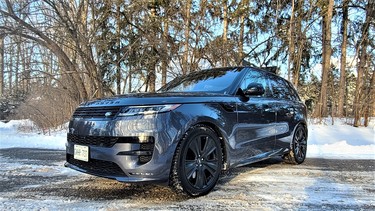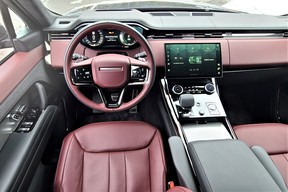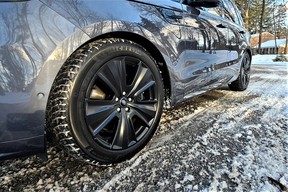Which powertrain is best for the Range Rover Sport: Gas versus plug-in hybrid in a battle for supremacy

Article content
Land Rover Range Rovers have always been amongst my favourite cars to test. Extremely comely parked in the driveway, they’re predictably versatile, able to untwist twisty roads, float along highways like a magic carpet ride and head to parts unknown — and unpaved — better than anything this side of a Jeep Wrangler Rubicon. As vehicles versatile, they are all but unmatched.
Advertisement 2
Article content
Indeed, they have but one problem. OK two, the second being the price. But even more trying — especially in these environmentally-challenging times — is that they do suck back the fossil fuel at a most alarming rate. As ravenous as first-year engineers discovering attending their first frat party, a constant supply of high-octane fuel is essential at all times and woe be he who takes his eye off the keg — er, fuel gauge — lest the party come to a crashing halt. Oh, and the less spoken about their tailpipe emissions — that would apply equally to both alcohol-soaked freshman and CO2-spewing supercharged V8s — the better.
The answer, of course, is electrification. A battery-powered electric would seem to be the obvious — that should be read trendy — solution, but Range Rover owners really do tend to rack up the miles to, as I said, some far-flung places. That’s why JLR has gone the PHEV route marrying its now ubiquitous 3.0-litre inline six with a plug-in battery and electric motor.
Advertisement 3
Article content
Article content
Advertisement 4
Article content
A number of questions arise. Does it actually conserve gas? Are emissions really reduced? How far can it go on a battery charge? And, perhaps most importantly, what sacrifices must be made compared with the P530 V8-powered version of the Sport in the name of planet-friendliness. The only way to find out was to put the plug-in through its paces and then pitch it against the P530 in a tete-a-tete comparison.
Here’s what we found out:
Finally, someone made a (PHEV) battery big enough
The bugaboo of all PHEVs — especially big plug-in sport brutes — is that they don’t offer enough electric-only range. To date, the best any (partially) electrified sport brute could manage was the 72 klicks Toyota’s RAV4 managed in perfect conditions. But it’s hardly big — or luxurious — now is it. But it’s fairly efficient squeaking out those 72 kilometres with just 18.1 kilowatt-hours of lithium ion.
Advertisement 5
Article content
Closer in size — and hedonism — is BMW’s X5 xDrive45e. When Range Finder last tested that beast, we were lucky to get 40 kilometres out of a full battery. Yes, its battery, at-24 kWh is bigger than the RAV4’s but so is the BMW and while more frugal than a gas-powered Bimmer, its relatively measly range meant few daily commutes were entirely fossil-free.
-

First Drive: 2023 Land Rover Range Rover Sport PHEV
-

Want a 2021 BMW X5 xDrive45e? Look at these plug-in hybrids, too
Land Rover solves this the old-fashioned way. As in more metal, in this case lithium carbonate. With 31.8 kilowatt-hours of useable lithium-ion squeezed under its floorboards, the Sport P440e boasts the biggest battery in any current PHEV sport ute. That means…
Advertisement 6
Article content
More range per charge
Officially, Land Rover says the Range Rover Sport P440e is good for 77 kilometres before gasoline meets piston. I beg to differ. I think 80+ would be a better estimate since I managed just such figures during Toronto’s recent snowstorm, the drain of -2C weather and slushy — i.e. higher friction — roads not diminishing its range. Not only that, some, maybe much, of that time was spent on the highway, hardly a battery’s best foot forward. Given purely city driving and better weather, I’m pretty sure I could squeeze 85 kilometres out of the big brute. Impressive stuff.

What a smooth ride
The big Range Rover is possibly the PHEV that best channels electrification. The ride, thanks to lots and lots of sound deadening material renders the ride almost silent. Seriously, the difference in interior calm between a Lucid Air — the class of all EVs — and the Sport P440e in EV mode is miniscule.
Advertisement 7
Article content
Also, unlike some plug-in hybrids, Range Rover allows you to access full EV mode even when it’s cold out (or, at least down to the -5C that we experienced in Toronto during my test). Lesser versions lock out using the battery exclusively when the mercury drops too much and kicks the gas engine in — yes, even when you’ve pushed the “EV” button — because the waste heat from internal combustion is an efficient way to warm up the interior without using precious kilowatt-hours. The electrified RRS only did this when the battery was almost empty and we tried to wake it up after a frigid night.
Said smoothness continues when the 3.0L gas engine does kick in. Inline sixes are the silkiest of internal combustion — save for V12s — and Land Rover’s rival BMW uses similar powerplants for fuss-free and vibrationless internal combustion. Seriously, if you’re just poodling along when the 440e’s battery gives up the ghost, it’s unlikely that you’ll even notice. Oh, when striving for the high notes — when your foot is really into it — it makes a bit of a (sonorous) roar but this is piston power at its least intrusive. It really is a sophisticated package.
Advertisement 8
Article content
Not half fast, as well
Officially boasting 434 horsepower — of which the electric motor mounted between the engine and eight-speed transmission contributes 141-hp — and 457 pound-feet of torque, the plug-in Range Rover is hardly a weakling. Indeed, despite weighing in at a hefty 2,658 kilograms — the penalty of those 31.8 kWh of battery — it still gets to 100 kilometres an hour in 5.8 seconds.
At least that’s the official count. It feels quicker. Certainly, I never wanted for power in my short test. Nor, again, is this the sort of unsophisticated powertrain that require pedal-to-the-metal, engine screaming revs to make decent progress. Thanks to that torquey electric motor and the I6’s twin turbochargers, just a brush of the throttle gets things moving smartly.
Advertisement 9
Article content

We’re not quite sure how frugal it is
Like all PHEVs, quantifying how much gasoline you’ll consume — and CO2 you’ll emit — is difficult with a plug-in battery. Never drive beyond the Sport P440e’s 80 or so kilometre EV range and you’ll drink not a drop. Drive it nonstop to Montreal with the gasoline engine working overtime and it’s not nearly as clean.
Of course, most people’s driving habits are somewhere in between. What I can say is that its 80+ kilometres range is exemplary for a PHEV and, when the lithium-ions do run out, the gas engine averages a little less than 10.0 L/100 km. Since most of my commutes were less than 80 klicks, I had no problem eking out exemplary overall fuel economy. A city dweller who plugs in religiously might sip as little as five or six litres per 100 kilometres while someone else, more prone to highway travel, might average eight. Either is excellent for such a large vehicle. And the Range Rover Sport PHEV helps one slip into the former category more than the latter by being one of the few PHEVs offering
Advertisement 10
Article content
The same DC fast-charging as BEVs
Unlike lesser PHEVs which are limited to low-wattage Level 1 charging, you can plug the Range Rover into a DC fast charger. Oh, the electrified Sport can’t match the 350-kW charging a Porsche Taycan boasts, but it is good for 50-kW which should get you a full battery charge in less than an hour, much better than most PHEVs. There’s also an onboard 7-kW charger for use at home and it takes a little less than six hours.
So, how does it compare to the all-gas V8-powered Range Rover Sport?
Very well, thank you. A Range Rover Sport powered by the company’s 4.4-litre supercharged V8 — so equipped, it’s called the P530 — is good for 523 horsepower and 553 pound-feet of torque, both numbers roughly 100 more than the electrified P444. It also weighs 2,430 kilograms, some 228 kilos less than the PHEV (like I said, those batteries are hefty) which is why it boasts a more impressive 4.5s sprint to 100 kilometres an hour.
Advertisement 11
Article content
That said, in everyday driving, there’s precious little difference between the two. Oh, summoning all that supercharged goodness will make things move in a bigger hurry. But, when passing traffic, climbing a big hill or just getting off the line in a (semi) hurry, it’s the PHEV that feels more relaxed.
Advertisement 12
Article content
And in the fuel economy sweepstakes, there’s no comparison at all. Figure on the V8-powered sucking back anywhere between 14 and 16 L/100 km (the official Transport Canada figures are 13.3 L/100 km, but good luck matching them). Depending on your particular urban-versus-highway split, that’s anywhere from 40 to 60 per cent worse than the plug-in hybrid with a commensurate reducing in greenhouse gasses as well.
Tally it all up and the PHEV is smoother, quieter, much more fuel conscious and, short of throttle-to-the-stop maximum motivation, feels all but as powerful. Frankly speaking, unless you’ve got a penchant for drag-racing SUVs — and if you do, may I suggest a Jeep Grand Cherokee Hellcat — the plug-in P440e has it all over the supercharged P530. The fact that it’s $10,600 cheaper — $123,050 versus $133,650 — makes the choice just that much easier.
Advertisement 13
Article content
The P440e is the best Range Rover Sport available and in the running for best PHEV extent. So much so that I can’t help but wonder if a similar powertrain might be a (partial) solution to the electrification of full-sized pickups. Having just spent a week in Ford’s F-150 Lightning, I can’t help but be impressed with its power and handling — both improvements due to electrification — but lament its absolutely abysmal highway range and slow charging. A long-range PHEV with a similarly frugal six-cylinder engine would solve many of the latter without hindering the former too much. Whatever the future of plug-in hybrids, automakers could do worse than following Range Rover’s lead.



Comments
Postmedia is committed to maintaining a lively but civil forum for discussion and encourage all readers to share their views on our articles. Comments may take up to an hour for moderation before appearing on the site. We ask you to keep your comments relevant and respectful. We have enabled email notifications—you will now receive an email if you receive a reply to your comment, there is an update to a comment thread you follow or if a user you follow comments. Visit our Community Guidelines for more information and details on how to adjust your email settings.
Join the Conversation